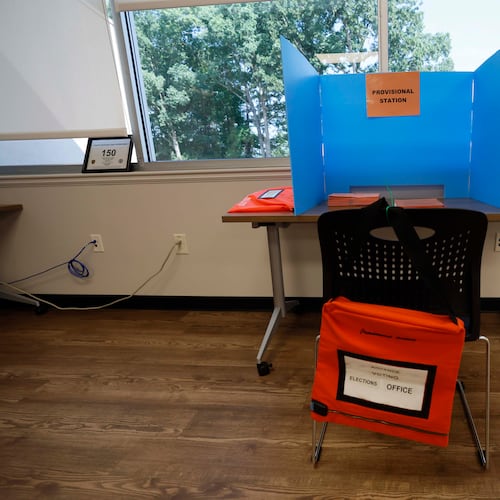Nikki Haley is the latest in a long line of South Carolina governors to stand among supporters and urge lawmakers in her state to do something about the Confederate flag.
David Beasley and Jim Hodges know first-hand what that’s like.
In interviews with The Atlanta Journal-Constitution, former S.C. governors Beasley and Hodges expressed hope that members of the House and Senate there will soon agree to move the Confederate flag from the Statehouse grounds once and for all. And, both lamented that it took such a tragedy to spur action.
“I’m obviously surprised by the lightning speed with which it’s happening right now,” Beasley, a Republican who served from 1995 to 1999, said. “Unfortunately it took the horrific deaths of some innocent and very wonderful people being killed.”
Haley, a Republican just starting her second term in office, this week called on lawmakers to lower the flag. It was a direct response to last week’s murder of nine black members of Emanuel AME Church, including the Rev. Clementa Pinckney, a Democratic member of the state Senate.
A 21-year-old white man is in custody in Charleston County, accused of their killings. The suspect has been tied to white supremacist movements, allegedly claimed he set out to start a race war and has been photographed with white-supremacist and Confederate flags and emblems.
Hodges and Beasley know intimately the difficulty of convincing South Carolinians to alter the symbols of their past.
Beasley, no fool, did not campaign as an anti-flag Republican in 1994. But, after a series of church burnings and other racial strife in the early years of his administration, the Hartsville native and descendant of a Civil War soldier, in late 1996 called for the flag to lowered from atop the Statehouse dome.
His initiative nearly paralyzed the General Assembly in 1997 and, ultimately, failed. Pro-flag organizations vowed revenge anyway, targeting Beasley as a traitor. Beasley lost to Hodges in 1998 at least in part because of the flag debacle. But like the defeat of then-Georgia Gov. Roy Barnes in 2002, there was more to it than just the fight over the flag.
“We fell short,” Beasley said this week. “We were against all odds.”
Still, he said, he believes his efforts led ultimately to the 2000 compromise that lowered the flag from the dome and raised a different version beside the Confederate monument on the Capitol grounds.
That’s where Hodges comes in.
Elected largely on the promise of robust investment in education and support for a Georgia-style lottery, Hodges, too, was on anti-flag crusader when elected. But the NAACP’s call for economic sanctions against South Carolina in 1999 nudged the stone down the hill. It gained speed and become a rushing boulder.
“Sanctions can no longer keep us from doing what’s right,” Hodges said in his January 2000 State of the State address. “Every one of us understands that we have two sovereign flags that represent all of us — the United States flag and the state flag with the palmetto tree and crescent.
“In its current location on the dome, the Confederate flag claims an inappropriate position of sovereignty. We must move the flag from the dome to a place of historical significance on the Statehouse grounds.”
After months of debate, on July 1, 2000, the Confederate battle flag was lowered from atop the dome and a smaller, square version of the South Carolina Infantry battle flag was hoisted atop a 30-foot pole on the Capitol’s front lawn.
It was an emotional ceremony, featuring thousands of anti-flag opponents unhappy with the compromise, and hundreds of flag supporters chanting, “Off the dome and in your face.”
And there the flag remains. Hodges said this week that the 2000 compromise accomplished more than lowering the flag from the dome. It ordered the flag to be removed from the House and Senate chambers and was also a key part of another compromise creating a Martin Luther King Jr. holiday.
“Those were two things that were very important,” he said.
Hodges said the new effort to move the flag “is a unifying signal to South Carolina. To do this is an effort to try and unify what is a very torn state over what happened.”
Hodges said that within moments of hearing about the Charleston murders, “I thought this is quickly going to turn into a discussion of the flag, and it did. You knew it was going to happen.”
Now, Hodges expects the Legislature to find the votes to furl the flag for good.
“You had nine innocent people murdered in church and you had these incredibly forgiving families — what person in their right mind is going to stand up and fight something like this?”
The anti-flag forces are not what they once were, he said.
“The demographics have changed,” he said. “Whites who are under 60 don’t tend to be so fixated on this issue. The flag lovers tend to be a diminishing group. Their numbers are dwindling.”
About the Author
Keep Reading
The Latest
Featured


